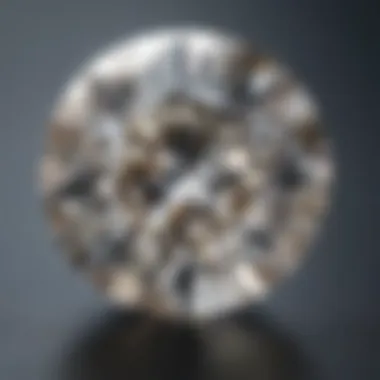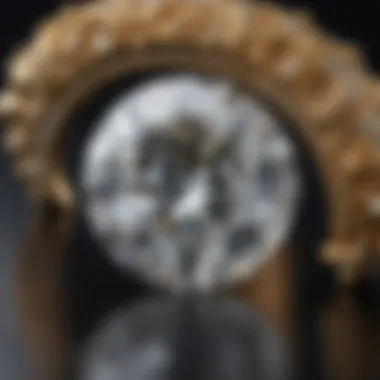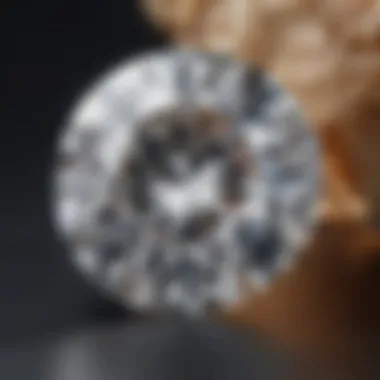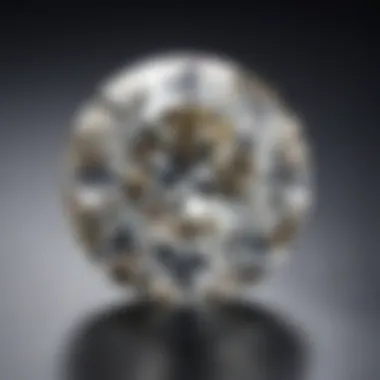Understanding 6mm Moissanite: Carat and Value


Intro
When pondering the world of gemstones, few can sidestep the shimmering allure of moissanite. Particularly, 6mm moissanite has garnered attention not just for its dazzling appearance but also for the intricate details that accompany its purchase and care. As a stone that offers a blend of beauty and value, understanding its carat measurement and significance becomes a journey worth taking.
In this article, we’ll delve into the intricacies of 6mm moissanite, looking at its properties, market appeal, and nuances compared to other gemstones. Whether you're a seasoned collector or just beginning to navigate the gemstone landscape, this examination will arm you with richer insights. From uncovering its origins to discussing factors that influence its value, the aim is to provide a thorough understanding of what makes this stone so unique.
Intro to Moissanite
In the realm of gemstones, moissanite stands out as a superb alternative to diamonds. This section dives into the essence of moissanite, shedding light on its significance in the world of jewelry and its growing prominence among gemstone enthusiasts. Understanding moissanite can help potential buyers appreciate its unique qualities, benefits, and various considerations.
Historical Overview
Moissanite has an intriguing history that dates back to the late 19th century. Discovered by the French chemist Henri Moissan in 1893, it originated from a meteorite in Arizona. Initially thought to be diamond, this gem's true composition was identified as silicon carbide, a substance not commonly found in nature. Fast forward to the 1990s, advancements in technology made it possible to produce synthetic moissanite in labs, making it widely available and significantly more affordable than natural diamonds.
It's fascinating how this gem, initially a curiosity from outer space, turned into a sought-after option for engagement rings and other fine jewelry. The transformation from rare, natural occurrences to accessible, lab-created stones significantly shaped perceptions and market demand.
What is Moissanite?
At its core, moissanite is a gemstone that mimics many of the characteristics of diamond but comes with its own distinct attributes. Composed of silicon carbide crystals, moissanite is celebrated for its exceptional brilliance and fire, often outshining diamonds due to its higher refractive index.
In terms of hardness, it ranks a commendable 9.25 on the Mohs scale, just below diamond, making it a durable choice for everyday wear. Moreover, moissanite is more resistant to scratching and is less likely to show wear over time, which is an appealing feature for those seeking longevity in their jewelry.
Comparative Analysis with Diamonds
When comparing moissanite to diamonds, several key aspects come into play:
- Brilliance: Moissanite's higher refractive index gives it greater brilliance, resulting in more flashes of light and a dazzling visual appeal.
- Color: While high-quality diamonds can display a range of colors, moissanite generally retains a more consistent and colorless appearance, depending on the grading.
- Price: The cost of moissanite is significantly lower than that of diamonds, allowing for options that cater to various budgets without compromising on style and beauty.
"Understanding these differences not only helps in making a more informed purchase but also elevates appreciation for both stones in their unique rights."
Defining Carats
When discussing gems in any depth, the term carat surfaces frequently. It plays an essential role in defining a gemstone's size and, ultimately, its value. Understanding carats is not just about numbers; it’s about knowing what those numbers signify in the gem world. This section aims to demystify the concept of carats, provide insights into how carat weight translates to visual characteristics, and correlate them with a 6mm moissanite’s placement in the jewelry market.
Understanding Carat Weight
Origin of Carat System
The origin of the carat system can be traced back to ancient times. It derives from the carob seeds once used as balance scales, the seeds having a consistent weight. This practical approach allowed traders to make fair exchanges effortlessly. Understanding the carat’s lineage brings a sense of respect for the system in modern gemology.
A key characteristic of the carat system is how it standardizes weight, ensuring all parties have a common reference point when buying or selling. It’s an important choice in the diamond and gemstone industry for various reasons. For one, it simplifies transactions by offering a universally accepted measure, preventing disputes and confusion. However, this system does have a downside; it does not always convey the stone's actual size perception, as two gemstones of the same carat weight can appear very different depending on their cut and dimensions.
How Carat is Measured
When you talk about how carat is measured, the process is crucial for accurately representing a gem's weight. A carat is equal to 200 milligrams, so knowing this basic conversion can provide a quick mental image of a stone’s heft. For moissanite, which often comes in varying shapes and sizes, the cut can influence how it appears to the naked eye.
The uniqueness of this measurement system lies in its precision. This exactness is not just essential for fairness; it's foundational for value calculations. However, one noteworthy limitation is how weight doesn’t always correlate neatly with size for stones of different materials. For instance, moissanite is typically less dense than diamonds, which can skew consumer perception when comparing the two. When you bring moissanite into the equation, understanding how these factors play together becomes even more significant.


Conversion of Millimeters to Carats
Converting millimeters to carats can seem tricky, but it's quite straightforward. Moissanite is measured in millimeters and tends to have a well-established rule. Generally, a 6mm moissanite is roughly equivalent to a 0.75 carat. Recognizing this conversion helps in comparing it with other stones you may come across.
"Understanding these conversions is essential for making informed decisions about purchasing moissanite."
While the size looks appealing at first glance, it's vital to remember that every millimeter adds more than just weight; it adds visual prominence. Therefore, being aware of how 6mm translates into weight is beneficial not only for buying but also for selling jewelry.
In closing, defining carats isn’t merely a matter of stating measurements. It encapsulates a rich tradition and a systematic approach that binds the jewelry world together. An appreciation of this allows gemstone enthusiasts to navigate their choices with greater clarity.
Characteristics of 6mm Moissanite
Understanding the characteristics of 6mm Moissanite is crucial for anyone diving into the world of gemstones. These traits don't just define the stone's appeal but also inform potential buyers and jewelry designers of its value and performance. The measurements, particularly its carat weight, and the ways it can dazzle with brilliance and fire are essential elements when considering a moissanite for various purposes. Each unique aspect adds layers of meaning to the overall aesthetic and financial aspects of this gem.
Carat Weight Conversion
Average Weight of 6mm Moissanite
A 6mm moissanite generally weighs around 0.75 to 0.85 carats, a figure that many find alluring when shopping for jewelry. This weight range is appealing, occupying that sweet spot where it feels substantial yet still manageable for everyday wear. The average weight of a 6mm moissanite exhibits a shimmering quality that garners attention without overwhelming the observer. The specific gravity of moissanite is similar but slightly less than diamonds, leading to a different perception of size.
This average weight makes a 6mm moissanite a popular choice for engagement rings and other statement pieces. When combined with a skillful cut, it showcases a brilliance that rivals more mainstream gemstones. This combination makes it a sought-after option, particularly for those desiring a sophisticated look without a hefty price tag.
Factors Affecting Weight Perception
While the stated carat weight gives a baseline understanding, factors affecting weight perception play a key role in how a moissanite is experienced visually. The cut quality and the depth of the stone can create an impression that the stone is lighter or heavier than it actually is. A shape that maximizes light reflection can enhance the brilliance even if the weight remains the same.
Moreover, surrounding elements—like the metal of the setting—also impact how one perceives the stone's weight. For instance, a well-chosen halo setting can give off an appearance that elevates the moissanite, making it look larger than its actual size. This is particularly beneficial for buyers who may want to make a bold statement without investing in larger carat stones.
Visual and Optical Properties
Brilliance and Fire
In terms of brilliance and fire, 6mm moissanite stands out with its ability to reflect light exceptionally well. Brilliance refers to the white light that a gemstone reflects, while fire denotes the colorful flashes of light. Moissanite has a higher refractive index than diamond, meaning it can exhibit more brilliance. This characteristic makes it a preferred choice for those seeking vibrant sparkle.
What’s also worth noting is that the cut contributes heavily to this effect. An expertly cut 6mm moissanite can maximize its brilliance, effectively drawing the eye. This fiery display captivates admirers and is often a conversation starter when showcasing such jewelry.
Clarity and Color Evaluation
When it comes to clarity and color, a 6mm moissanite generally ranks well. Most commercially available moissanites are near-colorless to colorless, making them similar to high-quality diamonds. Clarity refers to the absence of inclusions and blemishes; while some stones may have slight imperfections under magnification, they are often not visible to the naked eye.
This high level of clarity is a significant allure for buyers. It allows moissanite to be used in various settings without the risk of undesirable visual distractions. Nevertheless, choosing a piece from a reputable source ensures that you get clarity graded as promised. Good clarity enables the stone's sparkle to shine through, underscoring its potential for aesthetic beauty.
"Understanding moissanite’s visual properties empowers buyers to make informed decisions about their jewelry investments. The allure of sparkle can be both mesmerizing and practical."
In essence, the characteristics of 6mm moissanite intricately weave together to form a tapestry of qualities that appeal to gemstone enthusiasts, collectors, and jewelry designers alike.
The Role of Cut and Shape
When discussing Moissanite, the conversation often drifts towards its aesthetic qualities. The cut and shape of a gemstone significantly impact its visual allure and overall value. Much like a well-cut diamond, Moissanite’s cut can either highlight its fiery beauty or leave it looking dull and lifeless. Essentially, the cut of Moissanite serves as a pivotal piece in the puzzle of its appearance, affecting how light enters and exits the gemstone, thereby creating its captivating sparkle.


Another critical point is that the shape of the Moissanite, be it round, princess, or emerald, can dramatically alter its personality and the way it suits the wearer's style. Thus, understanding the influence of cut and shape is crucial for selecting a stone that not only looks stunning but also fits perfectly in jewelry settings. Keeping these considerations in mind, let’s delve into the popular cuts of Moissanite and explore their uniqueness.
Popular Cuts for Moissanite
Round Cut
The round cut is widely recognized as the most popular and traditional choice for Moissanite. This shape is revered for its ability to produce maximum brilliance and fire. The round cut features 58 facets, which are expertly arranged to ensure that light is refracted in a manner that creates a flattering sparkle. One of its main characteristics is the symmetry and balance achieved in the cut, which draws the eye effortlessly.
The brilliance offered by a round cut makes it a prime choice for engagement rings, a symbol of eternal love. However, the round cut’s most notable unique feature is its adaptability; it pairs well with various ring styles, from classic solitaires to intricate vintage designs. The primary disadvantage might be its higher cost due to the amount of rough stone lost during cutting, but many would argue that the return on beauty is worth the investment.
Princess Cut
The princess cut is another staple in the world of Moissanite, known for its striking square shape that offers a modern twist on traditional designs. This cut is admired for its sharp lines and corners, which add a different kind of character to the stone. Often, this cut is favored for its combination of elegance and a contemporary feel, making it a solid selection for various jewelry pieces.
A key characteristic of the princess cut is its excellent light performance. This results from the arrangement of its facets, which allows light to return beautifully. The unique aspect of this cut lies in its versatility; it contrasts wonderfully with other shapes when placed alongside them in multi-stone settings or appears stunning alone. The downside could be seen in its edges; they are prone to chipping, requiring a bit more care in daily wear compared to its round counterpart.
Emerald Cut
The emerald cut stands out due to its regal appearance and stepped facets, which create a unique hall of mirrors effect. This cut emphasizes clarity and color over sparkle, giving it an elegant and sophisticated allure. A key characteristic of the emerald cut is its rectangular shape with trimmed corners, which brings an air of vintage charm that resonates with many jewelry lovers.
One unique feature of the emerald cut is its ability to showcase the internal characteristics of Moissanite, meaning that color and clarity become focal points. However, some may view this as a disadvantage; any inclusions are easily visible, so choosing a high-quality stone is imperative. Those who appreciate a sophisticated look with understated elegance often gravitate towards emerald cuts.
Impact of Cut Quality on Brilliance
While the shape of a Moissanite often garners attention, the quality of the cut plays an equally crucial role in determining its brilliance. A well-cut stone allows light to penetrate and reflect properly, enhancing brilliance and creating that mesmerizing fire characteristic of Moissanite. Conversely, a poorly executed cut can trap light, dulling the stone's appearance.
Investing in a high-quality cut ensures the best possible display of the Moissanite’s unique optical properties, allowing it to shine brightly, akin to a celestial body in the night sky. Therefore, when selecting Moissanite, never overlook the importance of cut quality as it shapes not just the aesthetic but the overall experience of the gemstone.
Market Considerations for Moissanite
When it comes to exploring moissanite, especially the 6mm variety, understanding market dynamics becomes essential. The significance of price and how it compares with diamonds and other gemstones directly impacts a buyer’s decision. Moreover, being well-informed can lead to not only favorable purchases but also a deeper appreciation for the stone's unique qualities. Consumers need to consider factors such as pricing, availability, and potential value fluctuations when venturing into the moissanite market.
Pricing of Moissanite
Factors Influencing Price
Several elements play a role in determining the price of moissanite. One of the most significant factors is the size of the stone. Typically, as the carat weight increases, so does the price. However, the way moissanite is produced also affects its cost. Unlike diamonds, which take millions of years to form, moissanite can be created in laboratories in a matter of weeks. This synthetic nature often results in lower prices, making moissanite a popular choice for buyers looking for a balance between quality and cost.
Another factor is the color range. While some prefer the colorless stones, those with hints of color may be less expensive. Thus, the distinct characteristics—like cut precision and overall clarity—also serve as key determinants of price.
Pros of understanding these factors include:
- Better bargaining power when purchasing.
- The ability to identify genuine from overpriced stones.
The unique feature of price variability based on market trends allows informed buyers to seize opportunities. Knowing when to buy can save hundreds of dollars.
Comparative Pricing with Other Stones


When we turn to comparative pricing with other stones, it's pertinent to highlight how moissanite stands favorably against diamonds and other popular gemstones such as sapphires or rubies. Moissanite is often priced significantly lower than diamonds with similar visual qualities. According to various sources, moissanite can be about 10-15 times cheaper than a diamond of equal size. This affordability makes it a compelling alternative for those who desire the look of a diamond without the hefty price tag.
Still, there’s more. Many consumers appreciate moissanite for its brilliance and fire, attributes that are painstakingly enhanced through systematic polishing and cutting. While moissanite isn't yet as recognized as diamonds, its growing popularity signifies a shift among consumers towards valuing the stone’s splendor and value proposition.
In summary, comparing moissanite to other options underscores its unique advantage in the market—an affordable yet stunning alternative that doesn’t compromise on sparkle.
Buying Guide
When looking into purchasing a 6mm moissanite, there are several points to consider:
- Seller reputation: Always buy from a reputable jeweler. Check reviews and ratings.
- Certification: Ensure you receive proper certification verifying the stone's origin and quality. This document can protect against fraud.
- Return Policy: Understand the return and exchange policies before making a purchase. Mistakes happen, and flexibility could save the day.
With these insights in hand, navigating the market for 6mm moissanite becomes a more straightforward venture, empowering consumers to make informed choices.
There’s no substitute for knowledge, especially in the gemstone market; understanding the unique dynamics surrounding moissanite enhances not just buying power but also emotional satisfaction with the purchase.
Caring for Moissanite Jewelry
Caring for moissanite jewelry is crucial for anyone looking to maintain its beauty and integrity over time. Although moissanite is known for its high durability, similar to diamonds in many respects, proper maintenance is key to keeping it looking its best. Just like a timeless piece of art, the value and allure of moissanite can shine even brighter when given the care it deserves.
To get started, it's important to understand basic cleaning techniques that can help preserve the stone's brilliance without causing damage. Invest a little time regularly, and you will be rewarded with a stunning piece that remains the center of attention in any setting.
Cleaning Techniques
Cleaning moissanite jewelry effectively involves several steps that are surprisingly simple, allowing you to maintain its sparkle without breaking a sweat.
- Gentle Soak: Mix warm water with a few drops of mild dish soap. Submerge your moissanite jewelry in this solution for about 20 minutes. This step lifts dirt and oils without harsh scrubbing that may harm the stone.
- Soft Brush: Use a soft-bristled toothbrush to gently scrub the stone and its setting. Be sure to pay attention to any crevices where grime tends to hide.
- Rinse: After scrubbing, rinse thoroughly under lukewarm water to ensure all soap residue is gone. Try to use a strainer or cover the sink to avoid losing the piece.
- Drying: Use a lint-free cloth to wipe it down gently. This protects the stone from scratches and leaves it shining like there’s no tomorrow.
"Regular cleaning not only enhances the appearance of moissanite but also helps in spotting any potential settings that might need attention before they become a bigger issue."
Long-term Maintenance
Long-term care goes beyond cleaning, diving deeper into preserving the structural integrity and radiance of your moissanite. Here are some tips to consider:
- Avoid Exposure: Keep your moissanite jewelry away from harsh chemicals found in cleaners, pools, or household products. Chlorine can cloud the stone over time.
- Proper Storage: Store your jewelry in a soft cloth pouch or a dedicated compartment in a jewelry box to prevent scratching. Keeping it separate from other pieces ensures it won’t get damaged.
- Regular Inspections: At least once a year, have your jewelry checked by a professional jeweler, who can confirm that the stone is securely set and free from any wear issues. This proactive measure can save you trouble down the line.
- When to Remove It: Consider taking off your moissanite rings during activities like exercising, gardening, or doing household chores where it may be exposed to potential damage.
Concluding Insights
In the realm of fine gemstones, understanding the nuances of 6mm moissanite holds a wealth of significance, particularly when it comes to carat measurement. This article has endeavored to demystify how this captivating stone stands in the crowded marketplace of gemstones, which can often feel overwhelming for both enthusiasts and buyers alike. Carat weight, with its striking importance, serves not just as a measure of the gemstone's size, but also plays a defining role in its valuation, making each nuance worth careful consideration.
The discussion around the characteristics of 6mm moissanite, from its equivalency in carats to the factors affecting its appeal and value, lays a solid foundation for any potential engagement with this luminous stone. Most importantly, it informs the choices of those looking to invest in jewelry featuring moissanite. Grasping the intricacies of carat measurement opens the door to informed purchasing decisions, ensuring that individuals are not only pleased with their aesthetic choices but also with their financial investments.
Furthermore, exploring how moissanite compares to traditional gemstones provides invaluable insights into the broader market dynamics. It offers a glimpse into the shifting nature of consumer preferences, especially as more buyers seek alternatives to diamonds that deliver equivalent charm and sparkle. This shift accentuates the relevance of moissanite in today's jewelry space and invites an ongoing dialogue about sustainable and responsible gem practices.
"Understanding carat weight is pivotal for anyone looking to make educated choices in their gemstone purchases, especially with a rising star like moissanite."
Final Thoughts on Moissanite
As we draw the curtains on this exploration of 6mm moissanite, it is paramount to appreciate not only its carat measurement but also the broader narrative it encapsulates within the jewelry industry. Moissanite, while commonly viewed as an alternative to diamonds, possesses its unique allure and robust characteristics that deserve celebration.
The journey through carat weight, cut quality, and the expected visual brilliance sheds light on why this vibrant stone has garnered attention.
- Value for Money: Many find that attractive pricing adds to the appeal of moissanite, making it an appealing choice without compromising quality.
- Sustainability: With environmental concerns becoming increasingly crucial, moissanite's lab-grown origins present an ethically favorable alternative to traditionally mined gemstones.
- Versatility: Available in various cuts and styles, moissanite accommodates a wide range of preferences, catering to both contemporary and classic tastes.
In essence, understanding 6mm moissanite brings with it a profound appreciation of the advancements in gemstone technology and artistry. It isn't merely about the beauty encapsulated in a shiny stone; it's also about the narrative it brings and the choices it represents for today's informed jewelry aficionados.



